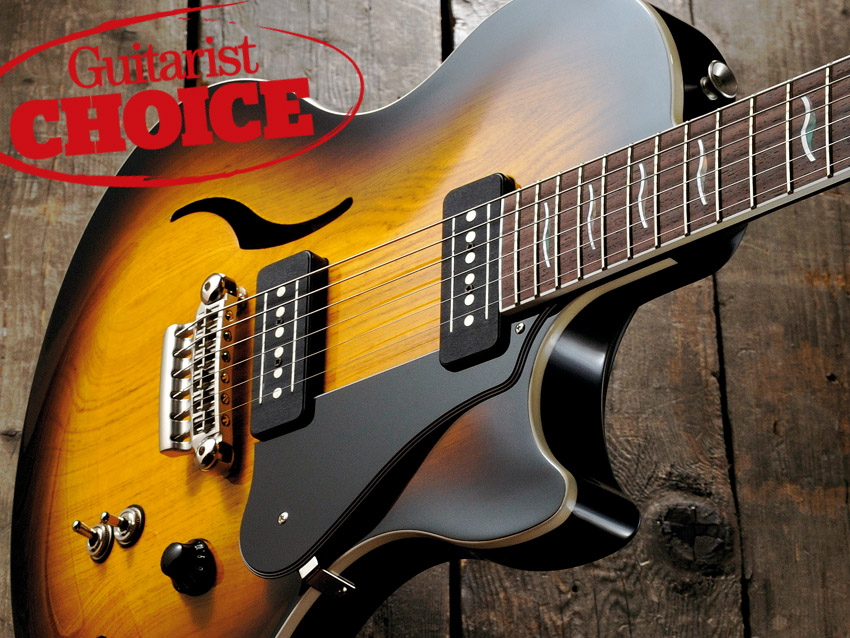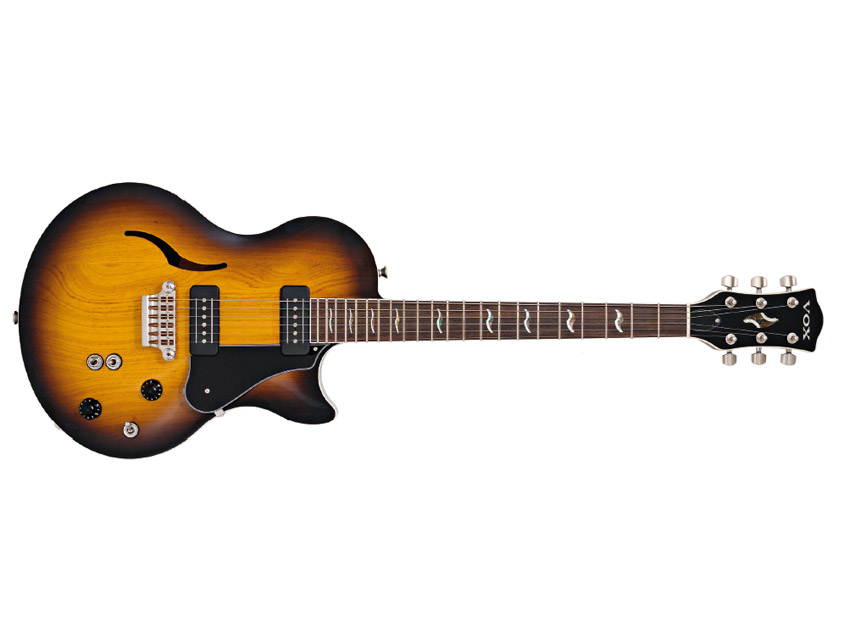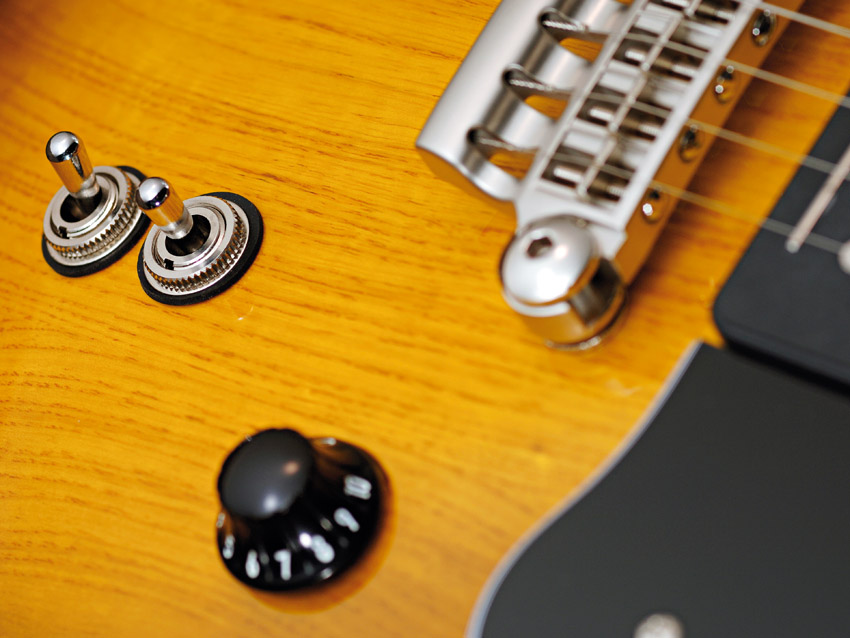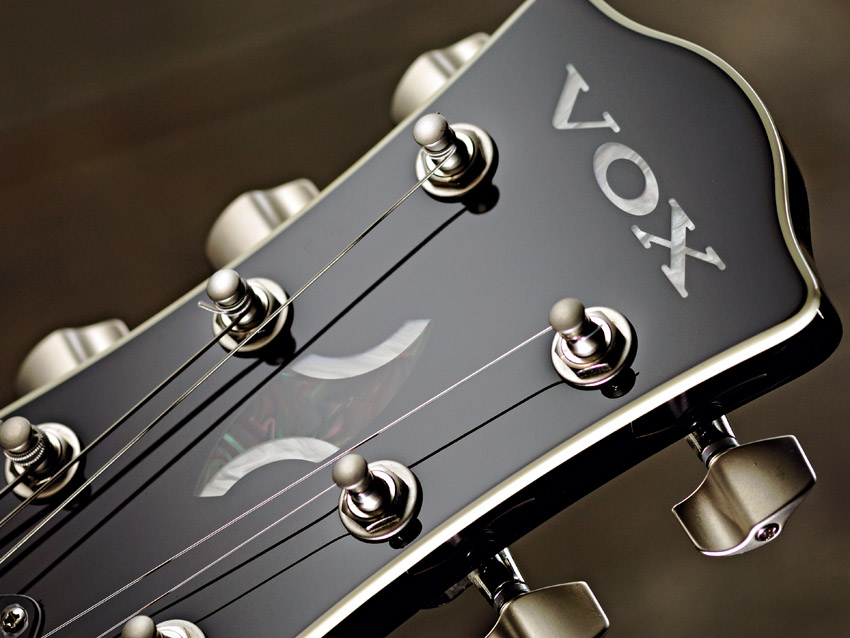MusicRadar Verdict
Slightly more solid sounding than its double-cutaway counterpart, the SC summons numerous tones from the past - a great instrument for the modern tonehound who likes to rock.
Pros
- +
Inspiring design. Light weight. Acoustic resonance. Sounds.
Cons
- -
Just the price.
MusicRadar's got your back

Vox Virage II SC

Vox Virage II SC

Vox Virage II SC

Vox Virage II SC
The original two Vox Virage guitars were launched in 2007 and over the past months we've looked at the new and expanded 2010 range - the 33, the 55 and 77 series. Finally we get a chance to look at the latest versions of that original Virage duo, now in their Mk II incarnations: the guitars that have inspired the lower-priced ranges.
The Virage range, which takes its name from the French word for bend or turn, comprises just two guitars: the single-cutaway (SC) and double-cutaway (DC). The former style appears in both the 33 and 55 ranges, but as a solidbody - the Virage SC is semi-solid.
"It's a subtly different voice with a bit more solidbody ring and push, and a little more width, but still with a hollowness and resonance."
The round-horned and clearly Gibson ES-335-inspired Virage DC is unique to this upper range, although its contoured and innovative semi-hollow body construction is utilised on the sharper-horned HDC77 model.
But there are plenty more stylistic similarities, not least in the fact that all the 2010 guitars use the same MaxContact bridge, the same CoAxe pickups and the 3D-style contouring of the bodies, which inspired the guitars' name.
However, unlike the other models, these Virages are made in limited numbers in Japan (as opposed to Indonesia) and are vastly more expensive guitars, aimed at 'connoisseurs' or 'artists'.
The more Les Paul-inspired SC version appears, upon initial inspection, to be more solid looking than its double cut counterpart - probably because it only has one f-hole. In fact it's pretty similar to the DC in terms of build. Here we have an ash top over a mahogany body, but unlike a typically maple-topped guitar, the ash forms the top half of the body, the mahogany the lower half.
Internally it's very similar - the majority of the wood is removed, leaving only the rims and the two prongs (or tone bars) of the partial centre block, like two over-sized bass bars running through the centre of the body from the neck to the feet of the MaxContact bridge. The overall top-carve is much like that of the DC too.
The back, however, is heavily edge-chamfered; it's a deep body too, and because it's not arched more mahogany is left in. This contributes to a slightly heavier, but still light weight and chunkier, more Les Paul-like girth, with a centre depth of approximately 60mm.
We only have top-edge binding here, again in keeping with Les Paul tradition. Obviously the single-cut design means the heel, which is sculpted away, is more angled than on the DC. But the neck itself is identical in terms of feel and appointments, although the shorter, unsupported length will bring its own rewards in terms of stiffness and sound.
We're impressed by the details - the strap buttons are widely flared; the very solid metal jack plates (originally just plastic) are perfectly aligned. Even the way the rear cavity coverplate is inset into a perfectly cut recess - it's impressive, detailed and careful guitar making.
Both guitars in the Virage II range use the same hardware and also electronics (which are the same on the 55 and 77 series and slightly simplified on the start-up 33 series).
Again superbly engineered, the cast aluminium MaxContact bridge has tune-o-matic- like saddle adjustment in that the height is altered by the two posts that hold it in place.
The strings enter from the rear, unlike a wrapover-style bridge, and about the only criticism we can level is that if your strings have rough wraps above the ball-end, you're going to feel them when you palm mute. Those uniquely shaped buttons certainly don't harm the tuners' performance either.
As with the other new Vox guitars we've recently reviewed the CoAxe pickups are different in design from the original Three-90 pickups, co-designed with and made by DiMarzio.
"The CoAxe pickups work quite a bit differently from the Three-90," explains designer Eric Kirkland. "The Three-90 has three conventional coils that are combined in various ways to create the different sounds. Two adjacent coils are combined in series for the 'lead' voice, the outside coils are combined in series for the 'crunch' voice, and two adjacent coils are combined in parallel for the 'clean' voice.
"This arrangement results in a good range of tone change across the modes, but for the next pickup we wanted to bring up the output level of the 'clean' mode while adding some emphasis to the attack on all modes.
"So we developed the CoAxe, based on the idea of coaxial coils. The central coil, being inside the magnetic field, is the sensing coil. The outer coil is outside the magnetic field and is used primarily for hum-cancelling.
"The benefit of this arrangement is that the hum-cancelling coil has both the six pole-pieces and the two blades as its core, so it requires less wire (about a third of the turns) to reach the same noise sensitivity as the centre coil.
"Less wire means lower impedance, which means the high frequencies are all there, but the noise isn't. Both the sensing and hum-cancelling coils are tapped, so we're able to achieve different tones and levels by engaging different parts of the coils."
To achieve the three modes that Kirkland describes we have a pair of chunky three-way switches that select, for each pickup, the clean (single-coil-y), crunch (P-90-ish) and lead (humbucking) modes. Then we have the similarly chunky three-way pickup selector, plus a master volume and tone.
Sounds
Initially the three humcancelling modes sound quite close, without the volume drop of the clean mode that we remember from the original Virages.
In truth the mode switch is more of a 'character' switch. Pushed down we get the lead voicing, a little fruitier with a rounded nose; pushed up we get the clean voicing, extra sparkle and less thickness.
The middle position is crunch, which sits in between - a little wider and fuller than clean but still with sparkle and a slightly down-shifted mid-range character.
If you're expecting three vastly different sounds you'll be disappointed, but use the nicely graduated volume control to clean up the clean mode, for example, and the subtle characters become much more distinct.
The SC feels great on the strap and the added brightness of this model, compared to the DC, subtly enhances the clean and crunch modes, making them a little more distinct.
It's a subtly different voice with a bit more solidbody ring and push, and a little more width, but still with a hollowness and resonance.
Both Virage II guitars edge into tuneful feedback when you need them to but, unless you really up the gain and volume, aren't troubled by intrusive howls.
Like a classic Vox AC30, neither guitar seems to want to do metal, but for a more organic, rootsy, classic rock they're bang on: cleans sound crisp but not sterile, and with a little tone roll off you're into Gretsch semi-solid territory.
Mid-crunch tones have depth and body but zing if needed, while old-style blues sound really good on the clean modes; and higher octane blues-rock wailing is easily achieved with the lead modes.
As befits the Vox name, both Virage II guitars reflect over 50 years of rock and pop, somehow touching all those bases but retaining their own specific character.
In that way these Mk II versions sound perhaps less three-guitars-in-one, and more one guitar with three characters that, if used with different amp tones (and the guitar's volume and tone controls), will reward the player who understands sound: these are two very, very musical instruments indeed.
Both are superbly made, with the more modern design flourishes enhancing the experience without feeling 'new', and both guitars also look appropriately classic without in any way cloning the instruments on which they're clearly based.
Modern guitar design doesn't get much better than this. There's no denying this is a pricey guitar, but careful quality like this is never cheap.
Dave Burrluck is one of the world’s most experienced guitar journalists, who started writing back in the '80s for International Musician and Recording World, co-founded The Guitar Magazine and has been the Gear Reviews Editor of Guitarist magazine for the past two decades. Along the way, Dave has been the sole author of The PRS Guitar Book and The Player's Guide to Guitar Maintenance as well as contributing to numerous other books on the electric guitar. Dave is an active gigging and recording musician and still finds time to make, repair and mod guitars, not least for Guitarist’s The Mod Squad.
“A fully playable electro-mechanical synth voice that tracks the pitch of your playing in real time”: Gamechanger Audio unveils the Motor Pedal – a real synth pedal with a “multi-modal gas pedal”
“It was the first rock monster that we'd created”: How an explosive 2001 switch-up revealed just how ferocious Muse could get
“I don’t think they’re New Order. They don’t sound anything like them”: Peter Hook takes aim at his estranged bandmates










